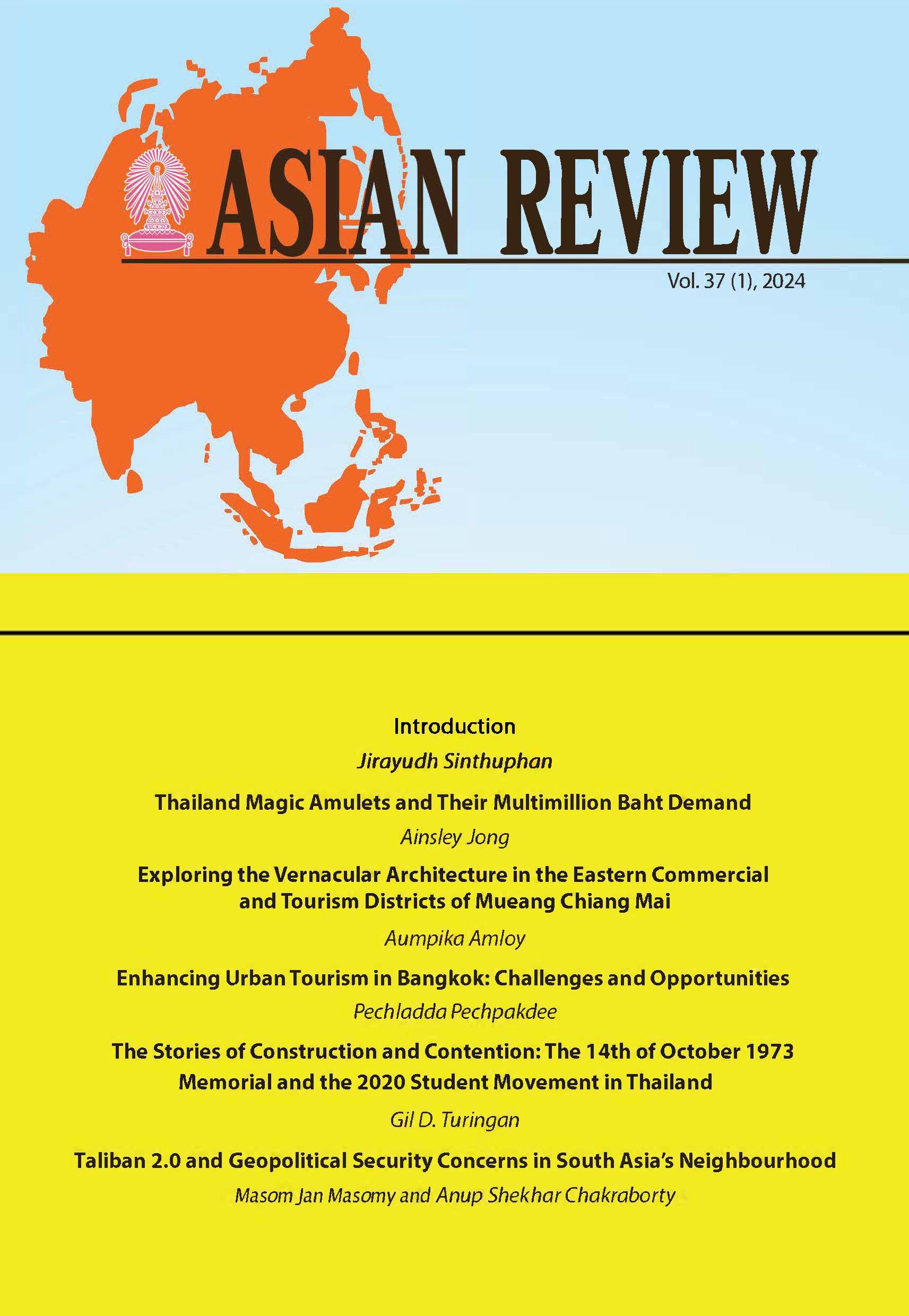Exploring the Vernacular Architecture in the Eastern Commercial and Tourism Districts of Mueang Chiang Mai
Keywords:
Vernacular Architecture, Chiang Mai, Cultural Influences, PreservationAbstract
This research article aims to analyze the vernacular architecture in the commercial and tourist districts of eastern Chiang Mai, covering the Chang Moi, Wat Ket, and San Pa Khoi districts. The methods of study are field surveys, historical documentation, and architectural analysis focusing on exploring the architectural elements, materials, and design principles that shape the urban environment in Mueang Chiang Mai. The study results identified six vernacular architecture styles in the study areas: wooden houses, wooden shophouses, wooden-concrete houses, wooden-concrete shophouses, concrete houses, and concrete shophouses. First, the vernacular architecture was built mainly from wood, representing the use of natural resources in the settlement area and local wisdom in construction. Second, the vernacular architecture was built with concrete and wood, combining local wisdom in traditional construction with modern construction techniques. Finally, vernacular architecture was built mainly with concrete, which uses both natural and engineering materials, reflecting the adaptation of vernacular architecture to support the popular functional changes over time, resulting in various improvement and developments. Conditions make vernacular architectural styles change from the original but still show the continuity of local wisdom in building, and timeless aesthetics. The prevalence and popularity of vernacular architecture styles found in the study area were 51 wooden houses in the Chang Moi district, 23 wooden-concrete houses in the Wat Ket district, and 8 concrete shophouses in the San Pa Khoi district.
References
Daungthima, Wittaya, and Tansukanun, Pranom. 2018. “Development of Neighbourhood and Districts of Chiang Mai City.” Journal of the Faculty of Architecture King Mongkut's Institute of Technology Ladkrabang 27, 2: 134-151.
Leaurungreong, Vitul. 2005. "The Local Architectural Intelligence for Comfortable Living in Commercial and Residential Buildings in Urban Areas in Chiang Mai and Luang Prabang." Journal of Architectural/Planning Research and Studies (JARS) 3: 51-68.
Muadthong, Amarit, Tovivich, Supitcha, and Panin, Ornsiri. 2019. "Chronology of Vernacular Architecture Study in Thailand: A Significant Movement." NAJUA: Architecture, Design and Built Environment 34,1: A1-A12.
Oranratmanee, Rawiwan. 2017. "Dynamic of Vernacular Architecture of Ethnic Groups: Case Studies of Tai Yai in Amphur Khun Yuam, Mae Hongson and Karen in Mae La Refugee Camp, Tak." Built Environment Inquiry Journal (BEI): Faculty of Architecture, Khon Kaen University 16,1: 1-16.
Satheinnam, Tanit, and Thungsakul, Nopadon. 2016. "Six Paradigms in the Vernacular Architectural Study." NAJUA: Architecture, Design and Built Environment 28: 265-282.
Shummadtayar, Umpiga, Tansukanun, Pranom, Suwatcharapinun, Sant, Kitika, Chiranthanin, and Pradit, Ajirapa. 2022. "Transformation Process of Local Study by the Youths for Engaging in Urban Development." Journal of the Faculty of Architecture King Mongkut's Institute of Technology Ladkrabang 35,2: 90-108.
Suwatcharapinun, Sant. 2015. "Reflection of Modernity: Re-exploring the Role of Modern
Architecture in Chiang Mai (1884-1975)." Journal of Architectural/Planning Research and Studies (JARS) 12,1: 79-102.
Suwatcharapinun, Sant, Tansukanun, Pranom, Shummadtayar, Umpiga, Kitika, Chiranthanin, and Pradit, Ajirapa. 2022. "Exploring theoretical framework and driving mechanism in community-based Chiang Mai learning city." JED: Journal of Environmental Design 9,2: 92-113.
Siriwatchaiporn, Paveena and Issarathumnoon, Wimonrart. 2018. "Adaptive re-use of vernacular houses for tourism in Wat Ket Community, Chiang Mai." JED: Journal of Environmental Design 5,2: 26-45.
Tansukanun, Pranom. 2019. "Daily life space of a local neighbourhood in the old city of Chiang Mai." JED: Journal of Environmental Design 6,2: 84-109.
Tansukanun, Pranom. 2023. A Place of the Soul: Chiang Mai Neighbourhoods. Chiang Mai: Pattrara Prepress.
Tansukanun, Pranom, and Daungthima, Wittaya. 2017. "A 'Sense of Place' of the Neighbourhoods in Historic Cities: The Case of Chiang Mai, Thailand." Built Environment Inquiry Journal (BEI): Faculty of Architecture, Khon Kaen University 16,1: 85-107.
Thinnakorn, Wirut, Tandikul, Chinasak, and Inpuntung, Vira. 2020. "The Evaluation of Vernacular Architecture's Value in an Old Town." NAJUA: Architecture, Design and Built Environment 35, no. 1 (2020): B19-B34.
Downloads
Published
How to Cite
Issue
Section
License
Copyright (c) 2024 Instiute of Asian Studies, Chulalongkorn University

This work is licensed under a Creative Commons Attribution-NonCommercial-NoDerivatives 4.0 International License.
Published articles are under the copyright of the Instiute of Asian Studies, Chulalongkorn University. Partially or totally publication of an article elsewhere is possible only after the consent from the editors.







